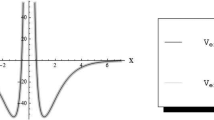Abstract
In this work, we analyze and compare different possible strategies for the transformations among low-rank (i.e., few number of terms) tensor approximations. The motivation behind this is to achieve compact yet accurate representations of potential-like operators (scalar fields) in symbolic or analytical form. We do this analysis from a formal and from a numerical perspective. Specifically, we concentrate on Tucker and Canonic Polyadic ansätze. We introduce the sum-of-product finite basis representations (SOP-FBR) for both. Here, the factor matrices (aka single-particle functions) are approximated through a set of auxiliary basis functions, specific to the system. In this way, analytical, grid-independent, low-rank expressions can be obtained. We illustrate how finite-precision arithmetic hinders transformations among all these forms. The solution to this issue seems to adapt current algorithms to high-precision arithmetic at the expense of an increase in CPU times.



Similar content being viewed by others
Data availability
The data that support the findings of this study are available from the corresponding author upon reasonable request.
Notes
(see https://numpy.org/doc/stable/user/basics.types.html#extended-precision).
References
X. Liu, K. K. Parhi, Tensor decomposition for model reduction in neural networks: a review. IEEE Circ. Syst. Mag. (2023)
R.L. Panadés-Barrueta, D. Peláez, Low-rank sum-of-products finite-basis-representation (SOP-FBR) of potential energy surfaces. J. Chem. Phys. 153, 234110 (2020)
A. Jäckle, H.-D. Meyer, Time-dependent calculation of reactive flux employing complex absorbing potentials: General aspects and application within MCTDH. J. Chem. Phys. 105, 6778 (1996)
G. A. Worth, M. H. Beck, A. Jäckle, H.-D. Meyer, The MCTDH Package, H.-D. Meyer, Version 8.4.12. See http://mctdh.uni-hd.de/ (2016)
G. A. Worth, K. Giri, G. W. Richings, I. Burghardt, M. H. Beck, A. Jäckle, H.-D. Meyer, The QUANTICS Package, Version 1.1, See: https://www2.chem.ucl.ac.uk/worthgrp/quantics/doc/quantics/citation.html/ (2015)
A.V. Mamonov, M.A. Olshanskii, Interpolatory tensorial reduced order models for parametric dynamical systems. Comput. Methods Appl. Mech. Eng. 397, 115122 (2022)
A. Jäckle, H.-D. Meyer, Product representation of potential energy surfaces. J. Chem. Phys. 104, 7974 (1996)
D. Peláez, H.-D. Meyer, The multigrid POTFIT (MGPF) method: grid representations of potentials for quantum dynamics of large systems. J. Chem. Phys. 138, 014108 (2013)
F. Otto, Multi-Layer Potfit: an accurate potential representation for efficient high-dimensional quantum dynamics. J. Chem. Phys. 140, 014106 (2014)
M. Schröder, H.-D. Meyer, Transforming high-dimensional potential energy surfaces into sum-of-products form using Monte Carlo methods. J. Chem. Phys. 147, 064105 (2017)
M. Schröder, Transforming high-dimensional potential energy surfaces into a canonical polyadic decomposition using Monte Carlo methods. J. Chem. Phys. 152, 024108 (2020)
F. Richter, M. Hochlaf, P. Rosmus, F. Gatti, H.-D. Meyer, A study of mode-selective trans-cis isomerisation in HONO using ab initio methodology. J. Chem. Phys. 120, 1306–1317 (2004)
N. Nadoveza, R. Panadés-Barrueta, L. Shi, F. Gatti, D. Peláez, Analytical high-dimensional operators in Canonical Polyadic Finite Basis Representation (CP-FBR). J. Chem. Phys. 158, 114109 (2023)
T.G. Kolda, B.W. Bader, Tensor decompositions and applications. SIAM Rev. 51, 455–500 (2009)
R.L. Panadés-Barrueta, E. Martínez-Núñez, D. Peláez, Specific reaction parameter multigrid POTFIT (SRP-MGPF): automatic generation of sum-of-products form potential energy surfaces for quantum dynamical calculations. Front. Chem. 7, 576 (2019)
E. Martínez-Núñez, G. L. Barnes, D. Glowacki, S. Kopec, D. Peláez, A. Rodríguez, R. Rodríguez-Fernández, R. J. Shannon, P. T. J. J. P. Stewart, S. A. Vázquez, AutoMeKin2021: An open-source program for automated reaction discovery. J. Comput. Chem. 1–13 (2021)
S. Kopec, E. Martínez-Núñez, J. Soto, D. Peláez, vdW-TSSCDS - An automated and global procedure for the computation of stationary points on intermolecular potential energy surfaces. Int. J. Quant. Chem. e26008 (2019)
S. Graillat, P. Langlois, N. Louvet, Algorithms for accurate, validated and fast polynomial evaluation. Jpn. J. Ind. Appl. Math. 26, 191–214 (2009)
D.H. Bailey, R. Barrio, J.M. Borwein, High-precision computation: mathematical physics and dynamics. Appl. Math. Comput. 218, 10106–10121 (2012)
H. Jiang, S. Li, L. Cheng, F. Su, Accurate evaluation of a polynomial and its derivative in Bernstein form. Comput. Math. Appl. 60, 744–755 (2010)
H. Jiang, R. Barrio, H. Li, X. Liao, L. Cheng, F. Su, Accurate evaluation of a polynomial in Chebyshev form. Appl. Math. Comput. 217, 9702–9716 (2011)
O. L. Polyansky, P. Jensen, J. Tennyson, The potential energy surface of H\(_2\ ^{16}O\). J. Chem. Phys. 105, 6490–6497 PES, water (1996)
J. J. P. Stewart, MOPAC2016, Stewart Computational Chemistry, Colorado Springs, CO, USA. http://OpenMOPAC.net (2016)
J. Richard Shewchuk, Adaptive precision floating-point arithmetic and fast robust geometric predicates. Disc. Comput. Geom. 18, 305–363 (1997)
T. mpmath development team, mpmath: a Python library for arbitrary-precision floating-point arithmetic (version 1.3.0). http://mpmath.org/ (2023)
Acknowledgements
NN is very grateful for its Ph.D. funding from the University Paris-Saclay. The authors are very thankful to J.-Y. Bazzara and A. Borissov (ISMO) for their computer support.
Author information
Authors and Affiliations
Corresponding authors
Rights and permissions
Springer Nature or its licensor (e.g. a society or other partner) holds exclusive rights to this article under a publishing agreement with the author(s) or other rightsholder(s); author self-archiving of the accepted manuscript version of this article is solely governed by the terms of such publishing agreement and applicable law.
About this article
Cite this article
Panadés-Barrueta, R.L., Nadoveza, N., Gatti, F. et al. On the sum-of-products to product-of-sums transformation between analytical low-rank approximations in finite basis representation. Eur. Phys. J. Spec. Top. 232, 1897–1904 (2023). https://doi.org/10.1140/epjs/s11734-023-00928-z
Received:
Accepted:
Published:
Issue Date:
DOI: https://doi.org/10.1140/epjs/s11734-023-00928-z




